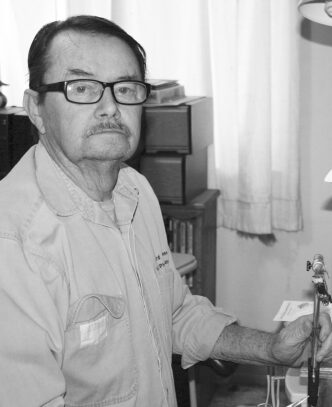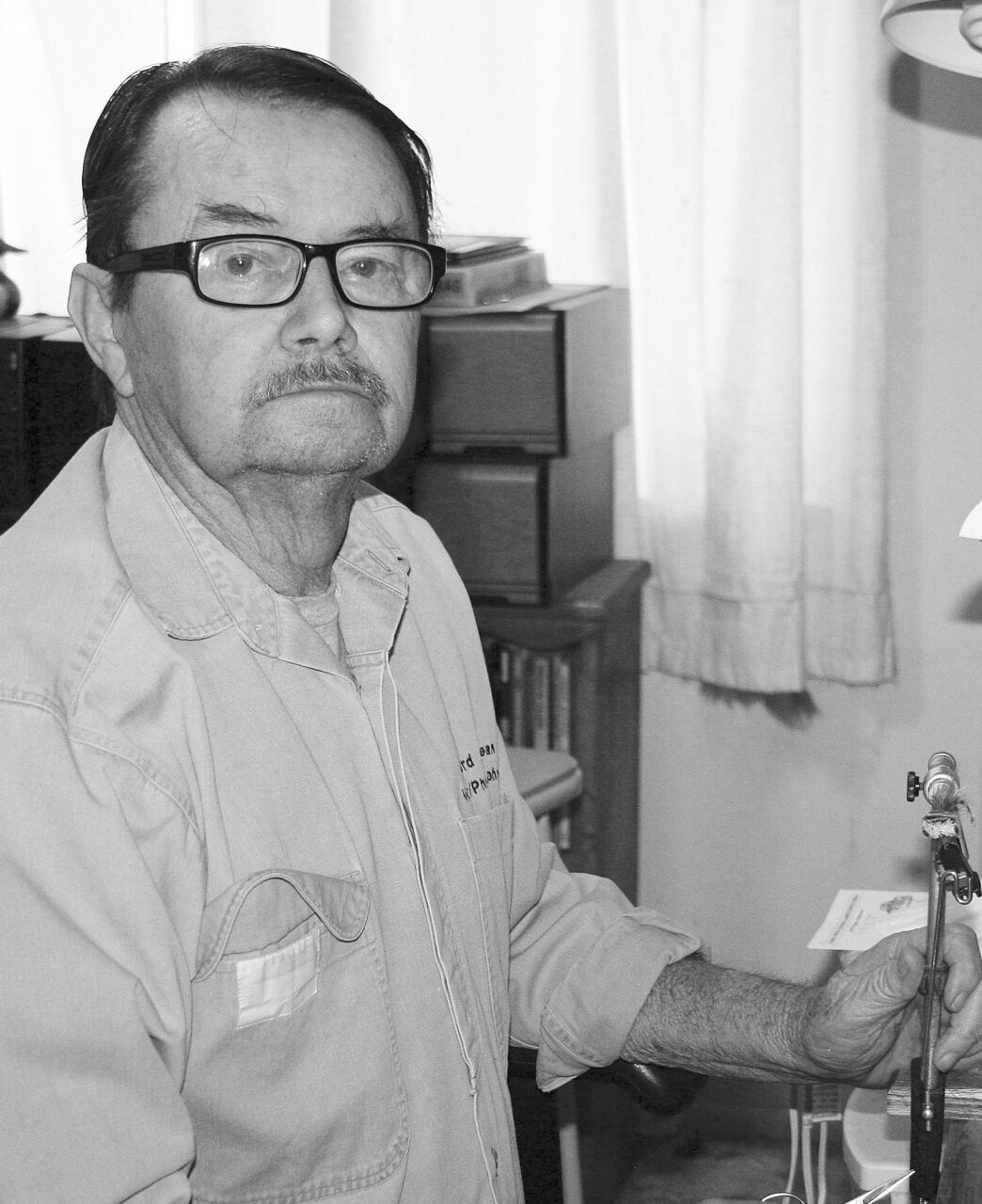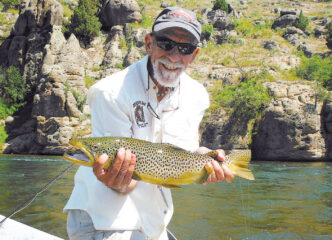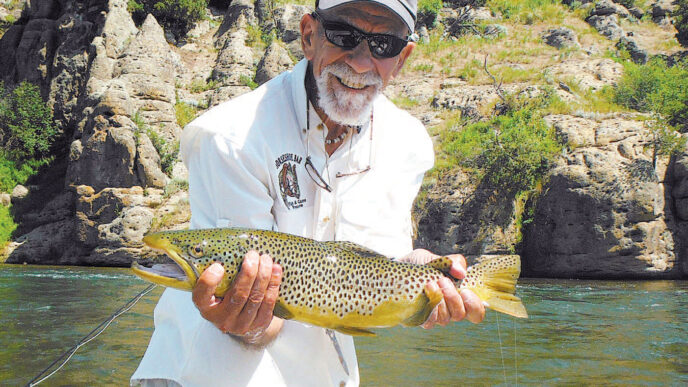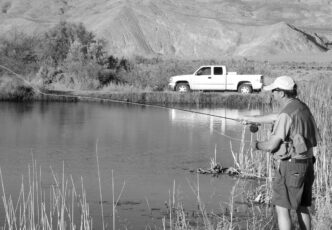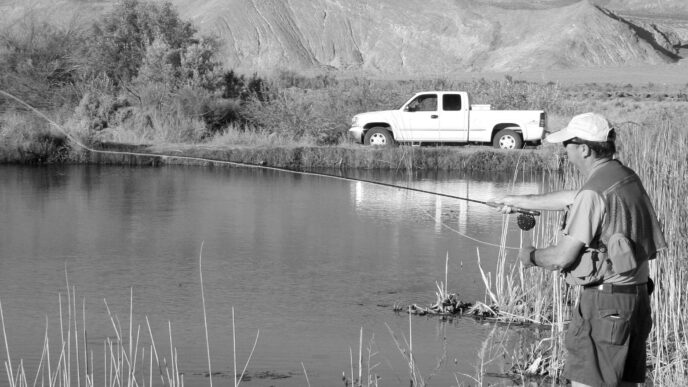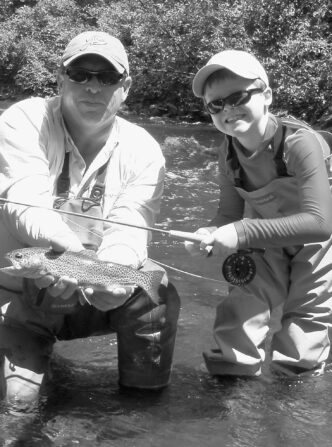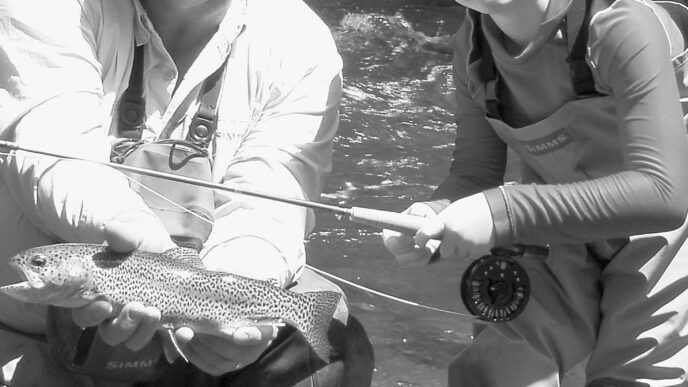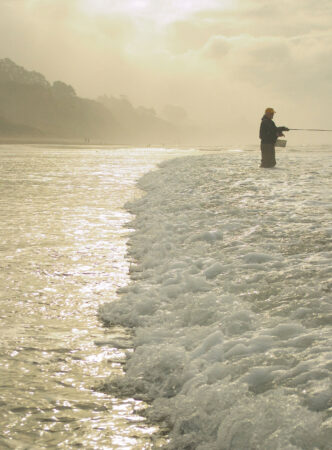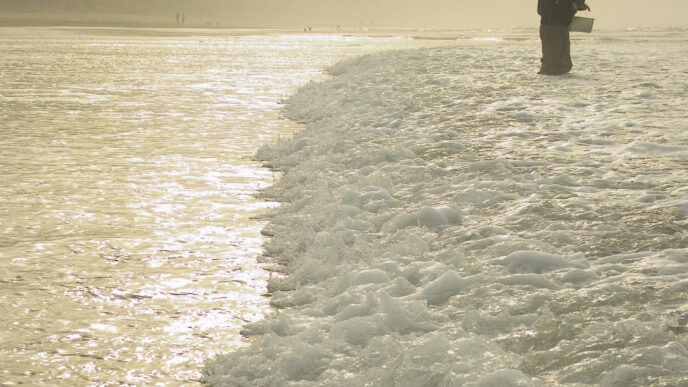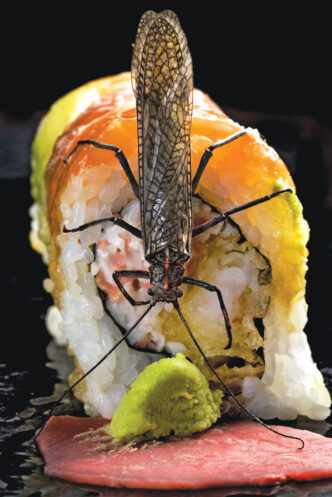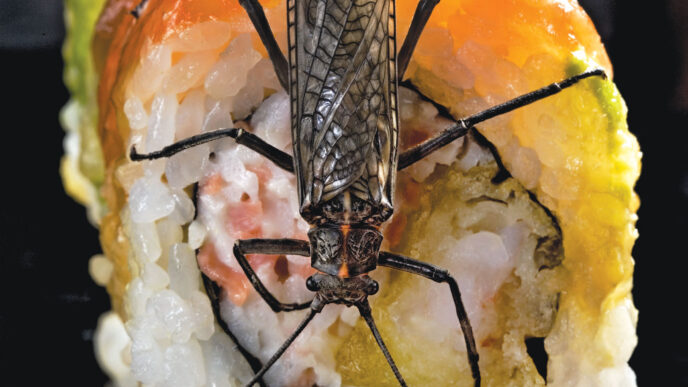If you’re a California fly fisher, and especially a Southern California fly fisher, a lot of what you know about the opportunities for freshwater angling in the Southland comes from Richard Alden Bean. That’s not just via California Fly Fisher, either. Rick is the author of a definitive angler’s guide to the region, Fly Fishing Southern California’s Lakes and Streams, originally published by Richard Anderson’s Aguabonita Books in 2000 and still available on the used-book market. Another longtime regular in the pages of this magazine, he has fished the area for nearly half a century and knows well what it was like, what it now offers, and what it can offer fly fishers in the future. With the twentieth anniversary of the magazine upon us, no one could better represent its ongoing coverage of trout, bass, and panfish angling in the southern part of the state than Rick Bean.
Bud: If I recall correctly, you’re originally from California, but grew up in Utah, in the extreme southwest corner, near Zion National Park, where Utah, Nevada, and Arizona meet. In some ways, that seems like the antithesis of the Los Angeles area, at least in terms of the stereotype of L.A. What was it like growing up there, and did you fish? What brought you back to Southern California?
Rick: Yes, I am a California native. I was born in the (then) little burg of Hemet, in July of 1941. Mom was from Utah, and when my stepfather, Bill Bean, started really suffering from arthritis, his doctor told him to move to a dry climate. He and Mom went off on a trip, leaving me with my aunt and uncle, and found a nice little high-desert town in southern Utah — beautiful red rock country, and dry as a bone. We moved there in 1948, when I was six, and moved back to California in 1958, when I was 16. I had the luck to be raised in a tiny town (1,320 people when we arrived, 1,320 when we left) where a kid could run free without harm and where both fishing and hunting were considered normal pursuits.
Kanab is the name of the town. I drove through there a few years ago, and about the only real change is the satellite dishes on the houses. We moved back to California to be near a veteran’s hospital when my stepfather developed Parkinson’s disease.
I’ve never gotten used to the pace of things in California. When my family moved back, it was first to Big Bear Lake (a small town again), then to Riverside when it was still a small city. Then eventually my I moved to the small desert town of Hesperia in 1980, and I’ve been here ever since. The damn town grew into a city around me, but I like the weather and the access to Southern California’s fishing and hunting, so I’ve stayed.
Bud: All of us associated with the magazine have or have had day jobs — angling journalism is not exactly the way to wealth. In your writing, you frequently mention going fishing after work. What were you doing when you weren’t fishing or writing about it? And you’ve also had a real career as an angling journalist, not just for this magazine, but for other publications. Lots of people grow up fishing and either keep at it or come back to it at some point in their lives, but only a few try to write about it, and even fewer write about it as well and as successfully as you do.
Likewise, you have written extensively on other subjects, including automotive and motorcycle repair. What made you a writer, and how did that aspect of your life develop?
Rick: After losing a job as an apprentice meat cutter (the head meat cutter absconded with a month’s receipts, and the owner closed the market), I was at loose ends at 19, so a friend and I joined the Navy. We both scored well, so we wound up in electronics training. He wanted to see the world, and I wanted a stateside base, because I was planning on getting married after training. He got stuck at China Lake Naval Station in Ridgecrest, California, and never saw salt water except when he went to the beach on weekends. I wanted a base, so I wound up on an aircraft carrier and made two long cruises to the South Pacific.
After the Navy, I returned to my wife and kids in Riverside and started looking for work. A family friend came by one evening about the time I was running out of unemployment insurance and told me about a job with the local Air National Guard unit at Ontario Airport. They were getting new aircraft, and their manning was due to go up. At first, I said no. Then he talked me into coming out to the small base and meeting the people. I took an instant liking to them, and there was a good job opening, so I put on a uniform again and joined the unit both as a weekend sergeant and a civil service employee. I worked there from 1965 to 1970 the first time.
About 1969, I started fooling around with photography. I was riding dirt motorcycles then as a hobby and started going to motorcycle races in the desert, bringing my camera along. While taking pictures at a race, I almost fell over a professional photographer and asked him about his job. He invited me to submit some pictures to the motorcycle news weekly he worked for, and within a few months, I was photographing and writing about desert racing. That evolved into photographing custom bikes and cars, mostly stuff I found at rod runs and shows.
In 1973, I got an offer to work as a writer for a start-up magazine publisher. I had sold them a few pieces, and they were probably desperate to get almost anything. In a year, I had been the editor of two of the company’s titles and was working on a third when I had a serious falling out with the owner and left. I freelanced for a year or so, then learned that my old job was coming open and went back to work for the Air National Guard.
After a couple of years, I got the itch to write again, and by then, I’d been out of the hot rod and custom motorcycle thing for so long, about the only thing I was competent at was fly fishing, so I started writing about that. I sold my first piece to Fly Fisherman in 1981. I retired from my military position as a master sergeant in the early 1980s and went full-time freelance a second time, and I have been doing that ever since.
Bud: OK, but lots of people get bitten by the writing bug. That doesn’t necessarily mean they can write and that what they write can get published. I’ve asked writers such as Scott Sadil about their apprenticeship to the craft of writing, and I’d like to hear more about yours. You’ve got a definite style — I can identify a Rick Bean piece without looking at the byline. How did you come by it?
Rick: I have no idea where the ability to write comes from, unless it was from my mom. She was a fine writer. She started doing “True Romance” and “True Confessions” pieces for those women’s magazines in the 1950s. We’d sit around the kitchen and get choked with laughter thinking up plots for those awful stories.
What she really wanted to do was write novels. So she did. She’d write in the mornings before she went to work and late at night after everything was done. Her first published novel, The Fancher Train, about a wagon train that was ambushed and destroyed by Mormons, was voted the Best Western Historical Novel in 1958 by the Western Writers of America. She wrote a couple of additional novels, but wound up working full-time as a technical writer for Rockwell and taking care of my dad and grandmother. What she taught me by example was that writing is something “normal” people do. The other person who had a great impact on my writing was a full-time freelancer by the name of LeRoy “Tex” Smith. He was the senior editor at the publishing company I went to work for. He edited my stuff and coached me. I mostly learned how to write by writing.
Bud: When I interviewed Richard Anderson for this column and asked him how he had found its contributors, he said, “It’s rarely me finding them, but them instead finding California Fly Fisher. As to why they contribute, you’ll have to ask each writer.” OK, I will. How did you end up writing for the mag, and why do you keep at it?
Rick: I found out about California Fly Fisher from my friend Jim Matthews, and since I was just about 100 percent fly fishing, I sent Richard a couple of things, and he bought them. I proposed the warmwater column mostly because Southern California has such fine fly fishing for bass and other warmwater critters that I thought it was a niche I might fit into. What motivated me to keep at it? Money.
Bud: Based on what you’ve written over the years, I think of you as something of a traditionalist. For example, you’ve championed the fishing of traditional flies such as the Bivisible for trout and praised the utility of fiberglass rods for bass bugging. Despite its modern profile as a high-tech, high-powered, competitive sport, bass angling in the United States actually has a long tradition of its own, and bass fishing with a fly rod is a part of that, going all the way back past Theodore Gordon and the adaptation of the British angling tradition to fishing for trout on these shores. And in contrast with the heritage of trout angling, which was burdened with its roots in the British class system, bass angling and angling for other warmwater fish traditionally has been an egalitarian, blue-collar kind of enterprise, today’s candy-apple metal flake bass boats and twenty-dollar lures to the contrary. As The Warmwater Fly Fisher of “The Warmwater Fly Fisher” column, you’ve in effect been both a custodian of that tradition and an advocate for its future, so I want to ask some questions about the past and future of warmwater angling in Southern California.
For starters, given the tweedy vibe associated with fly fishing, how much does warmwater fly fishing in the Southland reflect the egalitarian and blue-collar roots of warmwater fishing? Who’s doing it, and what kind of relations do warmwater fly fishers have with the larger warmwater angling community?
Rick: The fact that fly-rod bass angling is not high-speed or competitive is exactly why I like it. I never did think much of the bass tournament idea. Let me qualify that by noting that the professionals are great fishermen. I’ve learned a heck of a lot about bass from those guys — I just don’t want to fish with them if they are fishing a tournament. It’s no fun at all.
You know, it’s funny, but I agree with you that the roots of warmwater fly angling out here are blue collar. I hesitate to say that too often, because every time I do, I wind up talking to some bass fly angler who has a Ph.D. It’s enough to drive you nuts. Seriously, warmwater fly-fishing folk
in Southern California are still a minority among fly anglers and are almost lost among spin and bait anglers, but they are there in a kind of underground. You can’t separate them. I know most of them fish for trout, usually in the Sierra or in Montana or somewhere. There are not many die-hard bass fly rodders — not even me. I like to fly fish the local streams for small wild trout.
I suspect a large part of it was where I grew up. Southern Utah has little in the way of trout fly fishing. The streams and reservoirs that held trout were a couple of hours’ drive north. What we had locally — within bicycle distance, for a kid — when I was growing up were stock tanks and farmer’s ponds. They were full of bluegills and bass, but not trout. There was a state season on trout fishing at that time, and if you wanted to fish the rest of the year, you fished for panfish and bass.
I like the idea of year-round fishing such as you find in California, yet I sometimes wonder if the whole thing wasn’t better when we had a fixed season for trout angling, or for angling at all. It allowed you to switch focus when the season was closed and do other things. Where and when I grew up, hunting was more popular than fishing, and we did both. I don’t hunt very much anymore, but I still like the target practice and other stuff that comes with getting ready for the fall hunting seasons.
Bud: A lot of the warmwater angling venues in Southern California (and some of the trout waters, as well) are man-made, and some of them are pay-to-play waters, either municipal or private. In other words, the Southland is not the South, and Lake Castaic is not the bayou. How has this difference made a difference in the way warmwater fishing (and even trout fishing) has developed in Southern California?
Rick: It’s worse than that. There’s only one natural lake (Lake Elsinore) in Southern California, and it has been “enhanced” quite a bit by man. All the other stillwater fisheries are reservoirs. Some of the original reservoirs here have been there so long they are accepted as “natural” by most of us. As for changes, well, one thing I’ve seen over 35 years or so of fly fishing local reservoirs is that people no longer gawk at you when you show up with a fly rod There are more fly anglers now — not that that is a good thing, necessarily. The entrance and fishing fees charged by the operators of these reservoirs have shot up a lot over the years I’ve fished the area, but the quality of the fishing experience has diminished: too many people, especially on weekends. I fish the more popular spots only on a weekday now. Or maybe it’s just that I’m getting older and tend to view change with a more critical eye.
Bud: Some of the angling locations you’ve written about over the years have been off the radar of a lot of California fly fishers— the Colorado River, for example, and even the Salton Sea — and far away from the downright urban angling venues closer to the Los Angeles megalopolis. As a high desert rat, you seem to have a nose for water — water that holds fish. What advice would you give to adventurous fly fishers for sniffing out their own out-of-the-way places to fish?
Rick: The main thing is to get off the Internet bulletin boards that are just for fly anglers and start visiting the ones for the lure-and-bait folks. You aren’t trying to find out about fly fishing, but about fishing in general. When I visit a sports spot on the Web, I don’t look for what kinds of lures or bait they caught their fish on, but instead how many fish they caught and where. Then I call the closest tackle shop and ask questions. As an example, when the striped bass started to show in Diamond Valley Reservoir, I called and talked to a couple of local bait shops. After asking questions about the fishery, I knew the depth the stripers were holding at, how big they were, and what they were eating. I already knew how to translate that to fly fishing.
Make friends with some of the conventional tackle guys who are fishing a place you are interested in and pump them for information. They won’t necessarily tell you all their secrets, but since you are a fly fisher, they don’t see that as a threat to their fishing, and they’ll tell you quite a bit. You will probably find out that some of them fly fish for trout when they aren’t bait or lure fishing for a warmwater species.
Bud: I said that I think of you as something of a traditionalist, and that includes your approach to trout fishing. But maybe what I really mean is that you just have a no-nonsense approach. A lot of would-be trout anglers get intimidated by all the hoo-hah that surrounds the sport and its traditions. What would you tell them about the sport and how to approach it?
Rick: Fly fishing is at best just a hobby. It’s one of the things we do for fun. It’s not a religion, at least not at my house. I’ve loved the sport ever since I was a little kid, but it is not the only thing going on. I choose to fly fish because it is fun and pretty quickly lets you know that you have limits. I’ll pick up a bait-casting rod or spinning rod when conditions favor those methods, but I would rather cast a fly to most of the sport fish I’ve fished for. What I would tell anyone who is interested in fly fishing, for trout or anything else, is just that it is a hobby that almost anyone can experience and enjoy. One of the great things about fly fishing is that it leads to other things, such as conservation and a more critical eye for what various government agencies and big business may be doing to your favorite trout stream.
Bud: As an advocate for the future of fly fishing in Southern California, if you could have three wishes for what will happen to the sport in the next 20 years, what would they be? What would we need to do to make them come true?
Rick: If fly angling, or angling sport of any kind, is going to survive two more decades, we must make people understand that conserving the waters just cannot be ignored. Three wishes? First, somebody needs to shake up our Department of Fish and Wildlife and get it going on training a larger warden force. A much larger law enforcement presence is vital to maintaining our fisheries. I wish it wasn’t, but it is.
Second wish: I would like to see an end to all this fuss about non-native species. Introduced fishes have given us some of our best angling. I’d much rather fish for brown trout than other trout species. Remember, they were originally introduced to supplement native species that could not withstand the fishing pressure they were getting. Does anybody seriously think the pressure is going to lessen as we grow in population? The same goes for black bass and striped bass. They do not detract from our fisheries — they add to them.
The third thing I would wish for is a continued emphasis, both in the government and in our hobby, on maintaining and enhancing our native fisheries. I know that sounds at odds with my second wish, but it is not. We simply have to be smarter about where we do which. Some waters should be saved just for native game species, and others should be stocked with fish that can withstand a lot of angling pressure.
Bud: Here we already are at the traditional Silly Tree Question. If you were a tree, what kind of a tree would you be?
Rick: I think I’d like to be a big cottonwood perched on the bank of a good bass and bluegill pond. I’d be able to provide some shade and cover, and if I leaned out a little, I could watch the fish.



